![]()
![]()
![]()
Use LEFT and RIGHT arrow keys to navigate between flashcards;
Use UP and DOWN arrow keys to flip the card;
H to show hint;
A reads text to speech;
68 Cards in this Set
- Front
- Back
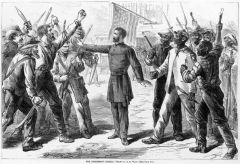
Freedmen's Bureau (1865) |
The Freedmen’s Bureau, was established in 1865 by Congress to help former black slaves and poor whites in the South in the aftermath of the U.S. Civil War (1861-65).
Some 4 million slaves gained their freedom as a result of the Union victory in the war, which left many communities in ruins and destroyed the South’s plantation-based economy.
The Freedmen’s Bureau provided food, housing and medical aid, established schools and offered legal assistance. It also attempted to settle former slaves on Confederate lands confiscated or abandoned during the war. (40 acres per person available for lease) |
|
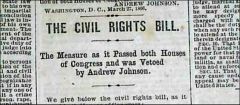
Civil Rights Act (1866) |
Passed by Radical Republicans, the Civil Rights Act was the first piece of congressional legislation to override state laws and protect civil liberties. It declared that all people born in the United States were citizens who had the right to life, personal freedom, property, and legal recourse. (Except for Native Americans).The Civil Rights Act was later made into the 14th amendment, making citizenship a birth right. |
|
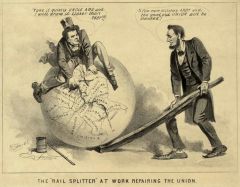
Lincoln's 10% Plan (1863) |
Aka Proclamation of Amnesty and Reconstruction. The 10% plan specified that a Southern state could be readmitted into the union if the minimum of 10% of its voters swore an oath of allegiance to the union. Everyone except high-ranking confederate army officers and government officials will be granted full pardon.
The 10% plan was more of a political maneuver than a plan for reconstruction it was lenient in an attempt to entice the South to surrender. Radical Republicans thought that the 10% plan was not harsh enough. |
|
|
How long did Reconstruction last? |
From 1865 to 1877. Reconstruction came in three successive parts: Lincoln's Plan, Andrew Johnson's plan AKA Presidential Reconstruction, and Radical Reconstruction. |
|
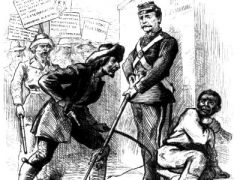
Black Codes (1865, 1866) |
Black Codes were laws passed by Southern states in 1865 and 1866, after the Civil War. These laws have the intent and effect of restricting African-Americans' freedom, compelling them to work in a labor Economy based on low wages or debt.
Black Codes undermined the 13th Amendment and kept African Americans as property-less agricultural labourers. Many were forced by their socioeconomic circumstances to work on the plantations of their former masters. These laws essentially brought serfdom to the US. |
|
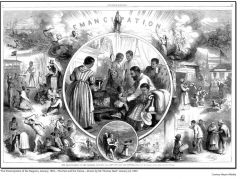
13th Amendment (1865) |
Formally abolished slavery. It declared that "neither slavery nor involuntary servitude, except as a punishment for a Crime whereof the party shall be duly convicted, shall exist within the United States, or any place subject to their jurisdiction." |
|
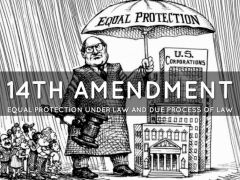
14th Amendment (1868) |
Granted citizenship to all persons born or naturalized in the US, including former slaves recently freed. Forbids States from denying any person "life liberty or property without due process of the law." |
|
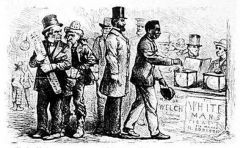
15th Amendment (1869) |
Granted African American men the right to vote by declaring that the "right of citizens of the US to vote shall not be denied or Abridged by the United States or by any state on account of race, color, or previous condition of servitude."
Congress required secessionist states that have not yet re-entered the union to ratify the amendment in order to rejoin. By 1870, three-quarters of the Union had ratified the amendment and it became law.
Although ratified in 1870 the promise of the 15th Amendment will not be fully realized for almost a century. Through the use of poll taxes literacy tests and other means, southern states were able to effectively disenfranchise African-Americans. It would take the passing of the Voting Rights Act of 1965 before the majority of African Americans in the South were registered to vote. |
|
|
Radical Reconstruction (1867-1877) |
Radical Republicans wanted a full reconstruction of the South. They passed the first reconstruction act, aka military reconstruction act, which reduced secessionist states to little more than conquered territory, dividing them into 5 military districts, each governed by a Union General, Congress declared Martial Law in the territories, dispatching troops to keep the peace and protect former slaves. |
|
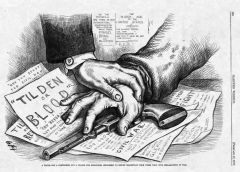
Bargain of 1877 |
Republican Party candidate Rutherford Hayes met in secret with moderate southern Democrats in order to negotiate the acceptance of Hayes' election. The Democrats agreed not to block Hayes' victory on the condition that Republicans withdraw all Federal troops in the south, thus consolidating Democratic control over the region. As a result of the so-called Compromise of 1877; Florida, Louisiana, and South Carolina became Democratic again, effectively marking the end of the reconstruction era. |
|

Plessy v. Ferguson (1896) |
This 1896 U.S. Supreme Court case upheld the constitutionality of segregation under the “separate but equal” doctrine. They voted 7-1. It stemmed from an 1892 incident in which African-American train passenger Homer Plessy refused to sit in a Jim Crow car, breaking a Louisiana law passed in 1890, The Separate Car Act .
|
|
|
Laissez-faire Liberalism |
The idea that individuals and businesses have the right to pursue there own interests without outside interference, i.e. government regulations. The argument for Laissez-faire is based upon the premise that free trade and unregulated economic activity will enhance economic growth by stimulating competitive Enterprise.
Since human beings are naturally motivated by self-interest, when they're not interfered with in their economic activities, a balanced system of production and exchange based on mutual benefits emerges (invisible hand of the market.)
Laissez-faire Liberalism led to the worst unemployment rate before the great Depression. In 1890, the richest 1% received as much wealth as the bottom half of US society, i.e. Robber Barons. |
|
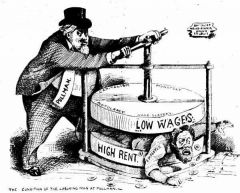
Pullman Strike (1894) |
Happened during the industrial revolution, when there was increased tension between industry, labor, and government. (Govt. supported industry over labor)
Industrialist George Pullman designed a model community around his rail car company. When his company laid off workers and lowered wages but failed to reduce rent, the workers formed the American Railway Union (ARU) in 1893 and called for a strike. The strike and boycott shut down much of the nation's Freight and passenger traffic West of Detroit. The strikers ended up committing a federal crime by inadvertently obstructing the delivery of mail. It let to Federal injunctions.
|
|
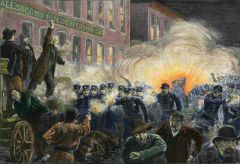
Haymarket Affair (1886) |
Started as a campaign to secure an 8-hour work day. Knights of Labor championed economic rights for Laborers; At the time it was the largest and most successful unit of organization in the US. During the Haymarket affair an unidentified person threw a bomb, kills a cop, and the cops start shooting at the protesters.
Anti-labor proponents painted protesters as violent and the Haymarket Riot created widespread hysteria directed against immigrants and labor leaders. Public distrust grows for the Knights of Labor. American Federation of Labor, which focused on skilled workers, replaces the Knights of Labor. Since the American Federation of Labor only accepted skilled workers, they effectively excluded women and African-Americans from the organization. |
|
|
Manifest Destiny (1846-1860) |
Enacted upon the premise that America has a god-given right to expand their territories, i.e. American exceptionalism. Characterized western expansion as natural and inevitable.
President James K. Polk oversaw the greatest territorial expansion of US. Polk accomplished this through the Annexation of Texas (1845), and negotiation of the Oregon Treaty with Great Britain (1846), and the conclusion of the Mexican-American War (1848) which ended with the signing and ratification of the Treaty of Guadalupe-Hidalgo (1848) |
|
|
Treaty of Guadalupe-Hidalgo (1848) |
More than 525,000 square miles of Mexican land is transferred to the U.S. Through the treaty, the U.S. became a continental Empire. Mexico ceded the present US states of Texas, Nevada, Arizona, California, Utah, and parts of New Mexico, Colorado, and Wyoming. The US paid $15 million in compensation, most of which went to Americans with claims against the Mexican Government. |
|
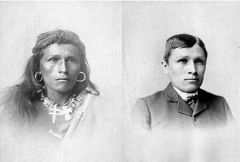
Carlisle Indian Industrial School (1879-1918) |
Federally funded off-reservation boarding school founded by Captain Richard Henry Pratt that "civilized" Native Americans. Essentially Europanized Native American children by forcibly assimilating them to mainstream American culture. In this period, many Anglo-Americans mistakenly believed that Native Americans were a vanishing race whose only hope for survival was rapid cultural transformation. |
|
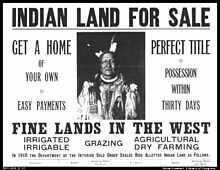
Dawes Act (1887) |
A federal law intended to turn Native Americans into farmers and landowners by providing cooperating families with 160 acres of reservation land for farming or 320 acres for grazing. These lands were held by the federal govt. in trust. If Native Americans took these lots, severed themselves from their tribes, and became "civilized" they would be granted American citizenship.
The objectives of the Dawes Act were to lift the Native Americans out of poverty and to stimulate their assimilation into mainstream American society.
Although generally well intentioned, the law greatly undermined Indian culture. Indian life deteriorated in a manner not anticipated by the act. The social structure of the tribe was weakened and many nomadic Indians were unable to adjust to an agricultural existence; others were swindled out of their property. Life on the reservation came to be characterized by disease, filth, poverty, and despondency. During the ensuing decades, 86 million out of 138 million acres of former Native American lands were lost to non-Natives. |
|
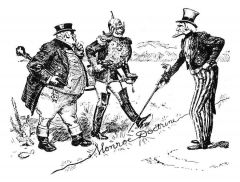
Monroe Doctrine (1823) |
Declared that any further efforts by European nations to take control of any independent state in North or South America would be viewed as a hostile act against the U.S.
At the same time, the doctrine noted that the US would neither interfere with existing European colonies, nor meddle in the internal concerns of European countries. |
|
|
Spanish-American War (1898) |
America wanted to expand its markets so the U.S. began to colonize nations overseas. They justified this expansion as bringing civilized society to non-civilized nations, AKA The White Man's Burden. The war only last 4 months but was wildly successful in terms of expansion. It led to the Treaty of Paris. |
|
|
Treaty of Paris (1898) |
Guam, Philippines, Puerto Rico, Cuba, and Hawaii is granted to the US by Spain. |
|
|
Teller Amendment (1898) |
Senator Henry M. Teller (Colorado) proposed an amendment to the U.S. declaration of war against Spain which proclaimed that the United States would not establish permanent control over Cuba.
It stated that the United States "hereby disclaims any disposition of intention to exercise sovereignty, jurisdiction, or control over said island except for pacification thereof, and asserts its determination, when that is accomplished, to leave the government and control of the island to its people."
True to the letter of the Teller Amendment, after Spanish troops left the island in 1898, the U.S. occupied Cuba until 1902 before granting them their independence. |
|
|
Seneca Falls Convention 1848 |
First Women's Conference, centered primarily on equal rights for women. Declaration of sentiments: "we hold these truths to be self-evident that all men and women are created equal... The History of mankind is a history of repeated injuries and usurpations on the part of man toward woman, having in direct object the establishment of an absolute tyranny over her."
Had its origins in the anti-slavery movement. For many white women, speaking about slavery made them recognize parallels between servitude and womanhood. Many abolitionists felt that women in the movement were playing too prominent a roll.
Language in the Fourteenth Amendment was clearly sexually biased. 15th amendment gave slaves the right to vote, but it still did not include women. |
|
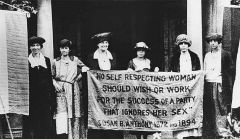
National Woman Suffrage Association 1869 (NWSA) |
Prominent members: Elizabeth Stanton and Susan B Anthony. Did not support the 15th Amendment because it did not include women. |
|
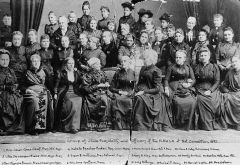
American Woman Suffrage Association 1869 (AWSA) |
Prominent members: Lucy Stone, Henry Blackwell, and Julia Ward Howe. Did support the 15th Amendment. Established six months after the National woman's Suffrage Association. |
|
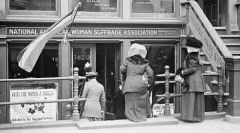
National American Woman Suffrage Association 1890 (NAWSA) |
Merger between National Woman Suffrage Association and the American Woman Suffrage Association |
|

Women's Suffrage |
In 1896, suffrage for women is available in 4 States; Idaho, Wyoming, Colorado, and Utah.
Full women's suffrage is not granted until 1920. |
|
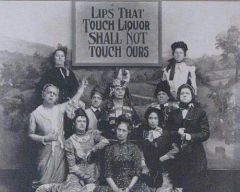
Women's Christian Temperance Union 1874 |
Prohibition movement. Functioned under the belief that alcohol addiction was hurting families, and the belief that women would support prohibition. In combination with the Abolitionist Movement and Settlement Movement, it served as a training ground for women in the public and political sphere. |
|
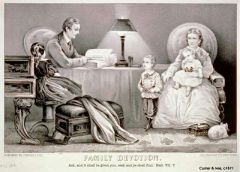
Cult of Domesticity |
Idea that men and women belong in separate sexual spheres of activity and influence. Men belonged in the public sphere. Women belong in the private sphere. Women were in charge of the home, men were in charge of bringing home the bacon. Promoted social motherhood or maternalism. |
|
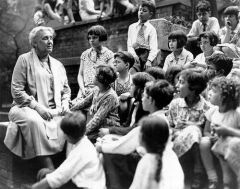
Jane Addams and Hull House 1889 |
Part of the settlement movement. Jane Addams was wealthy and after seeing the Toynbee Settlement in London (1884) she had the idea for the Hull house. She bought a house and turned it into a halfway house of sorts for disenfranchised children and impoverished peoples, mostly immigrants. The women who worked there lobbied for better living conditions for the impoverished.
The settlement movement as well as abolitionist and temperance movement served as the training ground for women who later joined the political sphere. |
|

Convict Lease System 1865-1928 |
After the Civil War, the South’s economy, society, and government were in shambles. Southern state governments struggled to raise money to repair damaged infrastructure and to support new expenses such as universal public education. The prison problem was especially challenging, as most prisons had been destroyed during the war.
Initially, some states paid private contractors to house and feed the prisoners. Within a few years, states realized they could lease out their convicts to local planters or industrialists who would pay minimal rates for the workers and be responsible for their housing and feeding, thereby eliminating costs and increasing revenue.
Soon, markets for convict laborers developed, with entrepreneurs buying and selling convict labor leases. Unlike slavery, employers had only a small capital investment in convict laborers, and little incentive to treat them well. Convict laborers were often dismally treated, but the convict lease system was highly profitable for the states and the employers.
Corruption, lack of accountability, and racial violence resulted in "one of the harshest and most exploitative labor systems known in American history." African Americans, mostly adult males, due to “vigorous and selective enforcement of laws and discriminatory sentencing,” made up the vast majority (but not all) of the convicts leased. |
|
|
Sharecropping System |
When the war ended, many freed African Americans saw the “40 acres and a mule” policy (set by Freemen's Bureau) as proof that they would finally be able to work their own land after years of servitude. Owning land was the key to economic independence and autonomy. Instead, as one of the first acts of Reconstruction, President Andrew Johnson ordered all land under federal control to be returned to its previous owners in the summer of 1865.
By the early 1870s, the system known as sharecropping had come to dominate agriculture across the cotton-planting South. Under this system, black families (and poor whites) would rent small plots of land, or shares, to work themselves; in return, they would give a portion of their crop to the landowner at the end of the year.
While sharecropping gave African Americans autonomy in their daily work and social lives, and freed them from the gang-labor system that had dominated during the slavery era, it often resulted in sharecroppers owing more to the landowner (for the use of tools and other supplies, for example) than they were able to repay. |
|
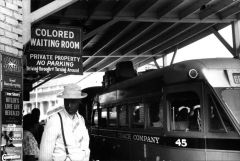
Jim Crow Laws 1877-1965 |
Was primarily used in the South and Southwest. It included segregation at facilities that were both publicly and privately owned. It impinged upon the rights granted by the Fourteenth and Fifteenth Amendment. For instance, during the Jim Crow era, to be able to vote, blacks must: pay poll taxes, pass property requirements, and literacy tests. The literacy tests ranged in difficulty depending on the white official giving the test. Sometimes simply reading too slow and stumbling upon words revoked a black person's right to vote.
To allow poor illiterate whites to vote, Grandfather Clauses were established. Grandfather clauses waves the property requirements and literacy test if a person's grandfather could vote prior to Reconstruction. Which is some racist ass ****. |
|
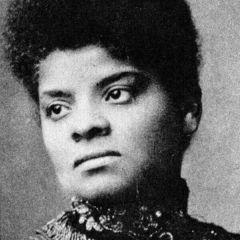
Ida Wells-Barnett |
Renowned anti-lynching crusader. The lynching of one of her friends was a galvanizing event. She was a journalist and a fierce advocate of civil rights. She wrote Southern Horrors (1892) and A Red Record (1895) |
|
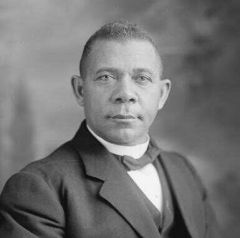
Booker T. Washington |
Born into slavery. In 1881, he became the principal of the Tuskegee school in Alabama. He believed that the best way fight segregation was to equip African Americans with practical agricultural training. He believed that a classical or liberal arts education did little for blacks in terms of social mobility. W.E.B Dubois Opposed this view. |
|
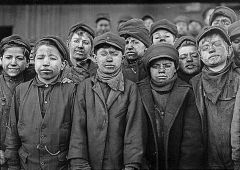
Industrial Revolution 1870-1916 |
Prior to the Civil War, America was an Agricultural Society. Industrialization brought about capitalism and consumerism, a change in labor workforce from Farmers to laborers, an explosion in production of raw materials and goods, and a massive growth of rail. At the end of industrialization the United States had more railways than the rest of the world combined.
Industrialization also led to socioeconomic inequality due to an unequal distribution of wealth, the exploitation of immigrant or convict workforces, child labor, and the rise of "captains of industry" AKA "robber barons" such as Andrew Carnegie, John D Rockefeller, JP Morgan. |
|

Chinese Exclusion Act 1882-1943 |
Set the precedent for using National Origins and race as a basis for exclusion and ineligibility for citizenship, as well is today's strict immigration laws. Began the Federal Regulation of immigration. Set the terms for the first large-scale deportation of an immigrant group. |
|
|
Page Law 1875 |
Precursor to Chinese Exclusion Act. Excluded Chinese contract laborers and women suspected of entering the country for lewd or immoral purposes. |
|

What is the Grand Depot? |
Opened by John Wanamaker in 1876, the Grand Depot was the first department store. He coined the term "customer is King," invented the money-back guarantee, and popularized the modern view of shopping, i.e. buying things as a recreational activity. |
|

1919 Chicago Race Riot |
Teenager Eugene Williams was riding a raft at the black side of the beach. When his raft drifted towards the white side of the beach, A white man threw rocks at him to get him to leave. Eugene gets hit on the head and drowns. A riot breaks out. |
|
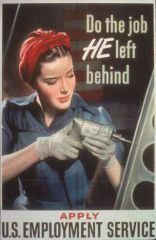
WW2 Female Roles |
In 1939 during World War II, things really start shifting in the social sphere. Since the men went off to war, women took the jobs of the men in the labor force. |
|
|
Progressive Era 1890-1920s |
Progressives are reformers who thought that the best response to the range of changes brought about by industrialization was for the state to intervene and regulate private institutions and thus curtail any problems that arise within and because of it. The movement paved the way for eugenic science, and the use of institutionalized sterilizations. |
|
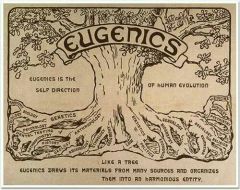
Eugenic Science |
Founded by Charles Galton, Charles Darwin's cousin. It is the science of better breeding through selective reproduction. Charles Davenport was a prominent figure in this movement.
"Positive Eugenics" focused on the reproduction of "fit" people. "Negative Eugenics" focused on the curtailment of "unfit" reproduction.
The American Eugenics movement formed the basis for the third reich's belief in a master race and their attempts to create one. The "Nordic" race is comparable to the "Aryan" race. |
|
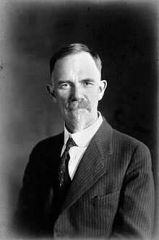
Charles Davenport |
Prominent figure in Eugenics. Opened the Station for Experimental Evolution (SEE) in 1904 through private funding. Opened the Eugenics Record Office (ERO) in Washington at 1910 through private funding. The ERO published The Trait Book in 1919 which was a seminal work in eugenic science. Eugenic science helped promote sterilization laws. The first of which was in Indiana in 1907. California also passed a sterilization law in 1909. By 1979, 20,000 sterilizations had been done in California which represented 1/3 of all sterilizations done in the US. 33 states had a sterilization law at some point. |
|
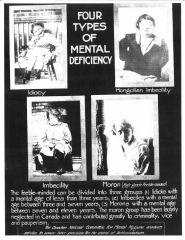
Feeble-mindedness |
A creation of eugenicists. Whoever scored 25 and below in an IQ test were labeled idiots, 25-50 were labeled imbeciles, and those who score 50-79 were labeled morons. High grade morons were considered as the most dangerous because they could pass as normal.
The feeble-minded pose an economic burden. Working class women were regarded as feeble-minded due to their gender and their choice of recreational activities. Their choice to mingle with men at dances and other places was considered a sign of sexual deviancy, as well as their choice to partake in recreational sex. They were considered high grade morons. |
|
|
Sonoma State Hospital 1885 |
After the California Sterilization Law of 1909 was passed, Sonoma State Hospital became the go-to place for sterilizations. Fred Butler was the hospital's superintendent for 43 years. He oversaw 5,400 sterilizations.
Between 1909 to 1979, 20,000 sterilizations we're done in California which represented one third of all sterilizations performed in the US. Sonoma State Hospital led in eugenic sterilization.
In 1917, a bill was passed to make a secondary hospital because Sonoma State Hospital became overcrowded and so the Pacific Colony was made. It opened in 1927. Female sexual "delinquency" was considered a good enough reason for sterilization. |
|
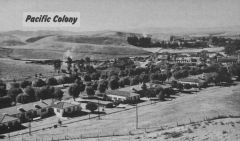
Pacific Colony 1927 |
The Pacific Colony AKA Moron Colony opened in 1927 and was based in Southern California. At the Pacific colony, Mexican descent women were sterilized at a disproportionate rate. In the 1930s to the 1950s, CA had a total Mexican population of 6 to 7%; however, Mexicans made up, on average, 23% of total sterilization authorizations. They were considered as these dirty, hyper fertile, and sexually devious morons who breed like rabbits and could, if left unattended, transform America into a mongrel race. |
|
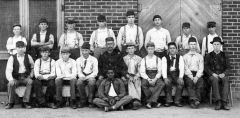
Whittier State School 1889 |
Opened in 1889 originally as a state reform school for juvenile offenders until Fred C. Nelles became the school superintendent. He transformed the school, which was more prison based & punitive, into one that was reformative. He used scientific based methods to figure out the root of delinquency.
Under his direction, researchers used various methods including Eugenics to figure out the source of juvenile delinquency. He became nationally renowned for the success of his methods and school. He eventually linked race to criminality, concluding that certain races are more susceptible to delinquency than others.
Whittier Social Case History Manual was published in 1921 |
|
|
California Bureau of Juvenile Research (CBJR) 1916 |
Opened in 1916. Director: J. Harold Williams. Western counterpart to Davenport's Eugenics Record Office. The CBJR published works that linked eugenics with racial inferiority. |
|
|
Immigration Restriction League (IRL) 1849-1914 |
Nativist group founded by Charles Warren. Focused on anti-chinese exclusion but later came to encompass all of Asian countries, especially India. |
|
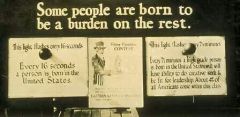
Dillingham Commission and Report (DCR) 1907-1911 |
The United States Immigration Commission, known as the "Dilingham Commission," was formed by the House and Senate Joint Commission in response to growing political concern about immigration. The report, published 1911, claimed that Southern and Eastern Europeans were of a degenerate stock with a predisposition for crime and their immigration should be regulated. The report also proposed literacy tests to weed out undesirables.
The commission's overall findings provided the rationale for the politically and economically inspired immigration acts of the 1920s: the Emergency Quota Act of 1921 and the Johnson-Reed Act of 1924. |
|
|
Immigrants' Protective League (IPL) 1908-1958 |
Proposed that degeneracy is a social and Institutional problem, race has nothing to do with it. |
|
|
Johnson-Reed Act 1924 |
AKA Immigration Act of 1924. Limited the number of immigrants allowed entry to the US through a National Origins Quota. The quota provided immigration visas to 2% of the total number of people of each nationality in the United States as of the 1890 National census. Created US border control. Completely barred immigration from Asian countries, Philippines included. |
|
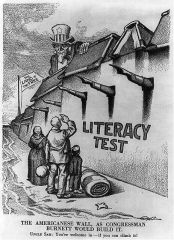
Asiatic Barred Zone 1917-1952 |
AKA Immigration Act of 1917. It imposed literacy tests on immigrants and barred immigration coming from the Asia-Pacific Zone, with the exception of the Philippines. |
|
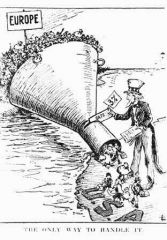
Emergency Quota Act 1921 |
AKA Immigration Act of 1921. Created an Immigration hierarchy based on National Origins. Set a quota system of 3% per country based on the 1910 US Census. No quota was set for the Asiatic Barred Zone or the Western Hemisphere. Many lobbied to exempt Mexico from the quota system because they were being utilized by big business as a cheap source of Labor. |
|
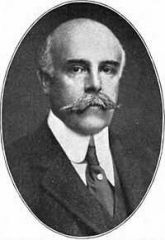
Madison Grant: The Passing of the Great Race 1916 |
The Passing of the Great Race was critically acclaimed after its 1916 publication. Grant was a huge proponent of eugenics and the immigration restriction League. His work presented Eugenics a wider audience. He divided Europeans into three races Nordic, Alpine, and Mediterranean. |
|
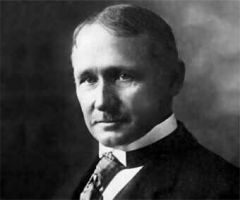
Frederick W. Taylor and Scientific Management |
Promoted efficiency in production, cost benefit analysis, etc. Did time-and-motion studies. Broke down labor into small tasks: "Factorization of labor." Established a wage incentive , i.e. if you pay your workers well enough, they will be more productive. |
|
|
Creation of Credit 1919 |
Started by General Motors to sell their cars. People could now pay in installments, making expensive purchases such as cars available to the average consumer. In 1924, 75% of car purchases used installment plans. In 1929, 60 to 90% major purchases used installment plans. Credit further reinforced the link between consumerism and happiness. |
|
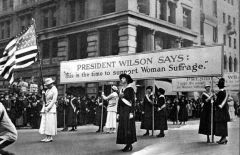
19th Amendment 1920 |
Ratified in 1920, the 19th Amendment to the US Constitution granted American women the right to vote, a right known as women's suffrage. |
|
|
Women's Joint Congressional Committee (WJCC) 1920-1930 |
An American Coalition of existing women's rights organizations formed after women gain the right to vote in 1920, with the aim of coordinating lobbying around women's issues at the national level.
Active from 1920 to 1930, this umbrella organization included the League of Women Voters, the Women's Trade Union League, and the National Consumers League, eventually coming to represent 12 million women. |
|
|
Sheppard-Towner Maternity and Infancy Act of 1921 |
In 1921, Congress passed the first federally funded social welfare program, the Sheppard-Towner Maternity and Infancy Protection Act to reduce alarming rates of maternal and infant mortality. The act provided support to states for prenatal and infant Health Care. |
|
|
Equal Rights Amendment 1923-Present |
The proposed Equal Rights Amendment (ERA) states that the rights guaranteed by the Constitution apply equally to all persons regardless of their sex. After the 19th Amendment affirming women’s right to vote was ratified in 1920, suffragist leader Alice Paul introduced the ERA in 1923 as the next step in bringing "equal justice under law" to all citizens |
|
|
Muller v. Oregon 1908 |
In 1903, Oregon passed a law that said that women could work no more than 10 hours a day in factories and laundries. A woman at Muller's laundry was required to work more than 10 hours. Muller was convicted of violating the law. His appeal eventually led to the US Supreme Court. By a 9-0 vote, the justices upheld the Oregon law. |
|
|
The National Woman's Party (NWP) 1921 |
The National Woman's Party (NWP) was an American women's organization formed in 1916 as an outgrowth of the Congressional Union, which in turn was formed in 1913 by Alice Paul and Lucy Burns to fight for women's suffrage, ignoring all other issues. It broke from the much larger National American Woman Suffrage Association, which was nationwide, and worked mostly on state suffrage in later years. The NWP prioritized the passage of a constitutional amendment ensuring women's suffrage. The National Woman's Party, like the Congressional Union, was tightly controlled by Paul, who learned from the even more militant suffragettes in Britain who used violence to gain publicity and force passage of suffrage. They denied the National Association of Colored Women any time, because they argued that African American women's issues were inseparable from race issues and would thus, dilute the cause. |
|
|
Hawaii Annexation 1898 |
In January 1893, Hawaiian planters staged an uprising to overthrow the Queen. At the same time, they appealed to the United States armed forces for protection. Without Presidential approval, marines stormed the islands, and the American minister to the islands raised the stars and stripes in HONOLULU.
The Queen was forced to abdicate, and the matter was left for Washington politicians to settle. By this time, Grover Cleveland had been inaugurated President. Cleveland was an outspoken anti-imperialist and thought Americans had acted shamefully in Hawaii. He withdrew the annexation treaty from the Senate and ordered an investigation into potential wrongdoings. Cleveland aimed to restore Liliuokalani to her throne, but American public sentiment strongly favored annexation.The matter was prolonged until after Cleveland left office. When war broke out with Spain in 1898, the military significance of Hawaiian naval bases as a way station to the SPANISH PHILIPPINES outweighed all other considerations. President William McKinley signed a joint resolution annexing the islands, much like the manner in which Texas joined the Union in 1845. Hawaii remained a territory until granted statehood as the fiftieth state in 1959. |
|
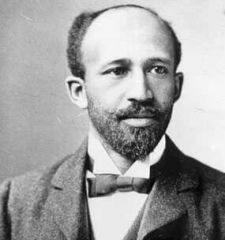
W.E.B. Dubois (1868-1963) |
First African American to earn a PHD. Dubois was a Harvard graduate, scholar, activist, author, sociologist, historian, and editor. Prominent social figure is civil rights movement.
Opposed Booker Washington's view that the best way for African-Americans to move upwards is through practical agricultural training. He believe that for African-Americans to rise up the social and civic ranks they must have a holistic education, one that involved both the classical and liberal arts.
His seminal work is Black Reconstruction in America published in 1935; an oppositional work to the Dunning school narrative. According to Dubois, reconstruction was good for the South. Reconstruction was Progressive, provided a true form of democracy, and provided educational reforms that benefited the long benighted. |
|
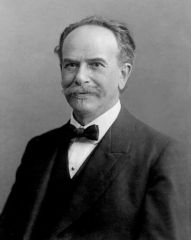
Franz Boas |
Franz Uri Boas was a German-American anthropologist and a pioneer of modern anthropology. He has been called the "Father of American Anthropology." He famously challenged Madison Grant and the eugenics movement. He argued that social environment and culture, not biology or race, shapes people. |
|
|
What is Fordism? |
Fordism is a term widely used to describe (1) the system of mass production that was pioneered in the early 20th century by the Ford Motor Company or (2) the typical postwar mode of economic growth and its associated political and social order in advanced capitalism. |

